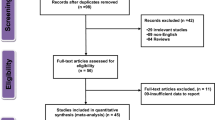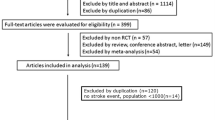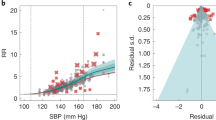Abstract
Stroke is the third leading cause of death in the US and a common cause of long-term disability worldwide. Ischemic strokes, which are often atherothrombotic, account for more than 80% of all strokes. Current stroke prevention focuses on optimizing the treatment of modifiable risk factors, such as hypertension, diabetes and dyslipidemia. The epidemiologic association between serum cholesterol levels and adjusted stroke rates is not as strong as the link between serum cholesterol levels and coronary heart disease. Clinical trials of 3-hydroxy-3-methylglutaryl-coenzyme A reductase inhibitors (statins), which are potent inhibitors of cholesterol synthesis, have demonstrated, however, a marked reduction in stroke risk in hypercholesterolemic and atherosclerotic individuals, with benefits extending to normocholesterolemic individuals. These findings suggest that statins might have additional effects in stroke protection beyond cholesterol reduction. Because statins inhibit the synthesis of isoprenoid intermediates in the cholesterol biosynthetic pathway, which are important lipid attachments for intracellular signaling molecules, they might have direct noncholesterol-dependent effects on inflammatory and endothelial cells. Here we discuss data from clinical trials assessing the effects of statins on stroke risk, as well as outline the mechanisms underlying the cholesterol-independent effects of statins and provide evidence-based recommendations for stroke prevention, based on achieved serum cholesterol levels in patients at risk of stroke.
This is a preview of subscription content, access via your institution
Access options
Subscribe to this journal
Receive 12 print issues and online access
$209.00 per year
only $17.42 per issue
Buy this article
- Purchase on Springer Link
- Instant access to full article PDF
Prices may be subject to local taxes which are calculated during checkout

Similar content being viewed by others
References
American Heart Association (2005) Heart Disease and Stroke Statistics—2005 Update. [http://www.americanheart.org/presenter.jhtml?identifier=3000090] (accessed 12 September 2005)
Liao JK et al. (1995) Oxidized low-density lipoprotein decreases the expression of endothelial nitric oxide synthase. J Biol Chem 270: 319–324
Vergnani et al. (2000) Effect of native and oxidized low-density lipoprotein on endothelial nitric oxide and superoxide production: key role of L-arginine availability. Circulation 101: 1261–1266
Iso H et al. (1989) Serum cholesterol levels and six-year mortality from stroke in 350,977 men screened for the multiple risk factor intervention trial. N Engl J Med 320: 904–910
Kagan A et al. (1980) Factors related to stroke incidence in Hawaii Japanese men. The Honolulu Heart Study. Stroke 11: 14–21
Leppala JM et al. (1999) Different risk factors for different stroke subtypes: association of blood pressure, cholesterol, and antioxidants. Stroke 30: 2535–2540
Horenstein RB et al. (2002) Cholesterol predicts stroke mortality in the Women's Pooling Project. Stroke 33: 1863–1868
Soyama Y et al. (2003) High-density lipoprotein cholesterol and risk of stroke in Japanese men and women: the Oyabe Study. Stroke 34: 863–868
Sacco RL et al. (2001) High-density lipoprotein cholesterol and ischemic stroke in the elderly: the Northern Manhattan Stroke Study. JAMA 285: 2729–2735
Tanne D et al. (2001) Blood lipids and first-ever ischemic stroke/transient ischemic attack in the Bezafibrate Infarction Prevention (BIP) Registry: high triglycerides constitute an independent risk factor. Circulation 104: 2892–2897
Goldstein LB et al. (2001) Primary prevention of ischemic stroke: a statement for healthcare professionals from the Stroke Council of the American Heart Association. Stroke 32: 280–299
Sacco RL (1997) Risk factors, outcomes, and stroke subtypes for ischemic stroke. Neurology 49 (Suppl): S39–S44
Gorelick PB et al. (1999) Prevention of a first stroke: a review of guidelines and a multidisciplinary consensus statement from the National Stroke Association. JAMA 281: 1112–1120
Landmesser U et al. (2005) Simvastatin versus ezetimibe: pleiotropic and lipid-lowering effects on endothelial function in humans. Circulation 111: 2356–2363
Furberg CD et al. (1994) Effect of lovastatin on early carotid atherosclerosis and cardiovascular events. Asymptomatic Carotid Artery Progression Study (ACAPS) Research Group. Circulation 90: 1679–1687
Crouse JR et al. (1995) Pravastatin, Lipids, and Atherosclerosis in the Carotid Arteries (PLAC-II). Am J Cardiol 75: 455–459
MacMahon S et al. (1998) Effects of lowering average of below-average cholesterol levels on the progression of carotid atherosclerosis: results of the LIPID Atherosclerosis Substudy. LIPID Trial Research Group. Circulation 97: 1784–1790
The Scandinavian Simvastatin Survival Study Investigators (1994) Randomised trial of cholesterol lowering in 4444 patients with coronary heart disease: the Scandinavian Simvastatin Survival Study (4S). Lancet 344: 1383–1389
The Long-Term Intervention with Pravastatin in Ischemic Disease (LIPID) Study Group (1998) Prevention of cardiovascular events and death with pravastatin in patients with coronary heart disease and a broad range of initial cholesterol levels. N Engl J Med 339: 1349–1357
Sacks FM et al. (1996) The effect of pravastatin on coronary events after myocardial infarction in patients with average cholesterol levels. Cholesterol and Recurrent Events Trial investigators. N Engl J Med 335: 1001–1009
Heart Protection Study Collaborative Group (2002) MRC/BHF Heart Protection Study of cholesterol lowering with simvastatin in 20,536 high-risk individuals: a randomised placebo-controlled trial. Lancet 360: 7–22
Collins R et al. (2004) Effects of cholesterol-lowering with simvastatin on stroke and other major vascular events in 20536 people with cerebrovascular disease or other high-risk conditions. Lancet 363: 757–767
Shepherd J et al. (1995) Prevention of coronary heart disease with pravastatin in men with hypercholesterolemia. West of Scotland Coronary Prevention Study Group. N Engl J Med 333: 1301–1307
Shepherd J et al. (2002) Pravastatin in elderly individuals at risk of vascular disease (PROSPER): a randomised controlled trial. Lancet 360: 1623–1630
Sever PS et al. (2003) Prevention of coronary and stroke events with atorvastatin in hypertensive patients who have average or lower-than-average cholesterol concentrations, in the Anglo-Scandinavian Cardiac Outcomes Trial—Lipid Lowering Arm (ASCOT-LLA): a multicentre randomised controlled trial. Lancet 361: 1149–1158
Colhoun HM et al. (2004) Primary prevention of cardiovascular disease with atorvastatin in type 2 diabetes in the Collaborative Atorvastatin Diabetes Study (CARDS): multicentre randomised placebo-controlled trial. Lancet 364: 685–696
ALLHAT Officers and Coordinators for the ALLHAT Collaborative Research Group. (2002) Major outcomes in moderately hypercholesterolemic, hypertensive patients randomized to pravastatin vs usual care: the Antihypertensive and Lipid-Lowering Treatment to Prevent Heart Attack Trial (ALLHAT-LLT). JAMA 288: 2998–3007
Waters DD et al. (2002) Effects of atorvastatin on stroke in patients with unstable angina or non-Q-wave myocardial infarction: a Myocardial Ischemia Reduction with Aggressive Cholesterol Lowering (MIRACL) substudy. Circulation 106: 1690–1695
Atkins D et al. (1993) Cholesterol reduction and the risk for stroke in men. A meta-analysis of randomized, controlled trials. Ann Intern Med 119: 136–145
Blauw GJ et al. (1997) Stroke, statins, and cholesterol. A meta-analysis of randomized, placebo-controlled, double-blind trials with HMG-CoA reductase inhibitors. Stroke 28: 946–950
Hebert PR et al. (1997) Cholesterol lowering with statin drugs, risk of stroke, and total mortality. An overview of randomized trials. JAMA 278: 313–321
Amarenco P et al. (2004) Statins in stroke prevention and carotid atherosclerosis: systematic review and up-to-date meta-analysis. Stroke 35: 2902–2909
Amarenco P et al. (2003) Design and baseline characteristics of the stroke prevention by aggressive reduction in cholesterol levels (SPARCL) study. Cerebrovasc Dis 16: 389–395
Multiple Risk Factor Intervention Trial Research Group (1982) Multiple risk factor intervention trial. Risk factor changes and mortality results. JAMA 248: 1465–1477
Sytkowski PA et al. (1990) Changes in risk factors and the decline in mortality from cardiovascular disease. The Framingham Heart Study. N Engl J Med 322: 1635–1641
Prospective Studies Collaboration (1995) Cholesterol, diastolic blood pressure, and stroke: 13,000 strokes in 450,000 people in 45 prospective cohorts. Lancet 346: 1647–1653
Tamai O et al. (1997) Single LDL apheresis improves endothelium-dependent vasodilatation in hypercholesterolemic humans. Circulation 95: 76–82
Laufs U et al. (2000) Suppression of endothelial nitric oxide production after withdrawal of statin treatment is mediated by negative feedback regulation of rho GTPase gene transcription. Circulation 102: 3104–3110
Cayatte AJ et al. (1994) Chronic inhibition of nitric oxide production accelerates neointima formation and impairs endothelial function in hypercholesterolemic rabbits. Arterioscler Thromb 14: 753–759
Huang Z et al. (1996) Enlarged infarcts in endothelial nitric oxide synthase knockout mice are attenuated by nitro-L-arginine. J Cereb Blood Flow Metab 16: 981–987
Laufs U et al. (1998) Upregulation of endothelial nitric oxide synthase by HMG CoA reductase inhibitors. Circulation 97: 1129–1135
Laufs U and Liao JK (1998) Post-transcriptional regulation of endothelial nitric oxide synthase mRNA stability by Rho GTPase. J Biol Chem 273: 24266–24271
Kureishi Y et al. (2000) The HMG-CoA reductase inhibitor simvastatin activates the protein kinase Akt and promotes angiogenesis in normocholesterolemic animals. Nature Med 6: 1004–1010
Urbich C et al. (2002) Double-edged role of statins in angiogenesis signaling. Circ Res 90: 737–744
Endres M et al. (1998) Stroke protection by 3-hydroxy-3-methylglutaryl (HMG)-CoA reductase inhibitors mediated by endothelial nitric oxide synthase. Proc Natl Acad Sci USA 95: 8880–8885
Lefer AM et al. (1999) Simvastatin preserves the ischemic-reperfused myocardium in normocholesterolemic rat hearts. Circulation 100: 178–184
Ridker PM et al. (2001) Measurement of C-reactive protein for the targeting of statin therapy in the primary prevention of acute coronary events. N Engl J Med 344: 1959–1965
Ridker PM, et al. (2005) C-reactive protein levels and outcomes after statin therapy. N Engl J Med 352: 20–28
Albert MA et al. (2001) Effect of statin therapy on C-reactive protein levels: the pravastatin inflammation/CRP evaluation (PRINCE): a randomized trial and cohort study. JAMA 286: 64–70
Sironi L et al. (2003) Treatment with statins after induction of focal ischemia in rats reduces the extent of brain damage. Arterioscler Thromb Vasc Biol 23: 322–327
Asahi M et al. (2005) Protective effects of statins involving both eNOS and tPA in focal cerebral ischemia. J Cereb Blood Flow Metab 25: 722–729
Chen J et al. (2003) Statins induce angiogenesis, neurogenesis, and synaptogenesis after stroke. Ann Neurol 53: 743–751
Expert Panel on Detection, Evaluation, And Treatment of High Blood Cholesterol In Adults (2001) Executive Summary of The Third Report of The National Cholesterol Education Program (NCEP) Expert Panel on Detection, Evaluation, And Treatment of High Blood Cholesterol In Adults (Adult Treatment Panel III). JAMA 285: 2486–2497
LaRosa JC et al.; Treating to New Targets (TNT) Investigators (2005) Intensive lipid lowering with atorvastatin in patients with stable coronary disease. N Engl J Med 352: 1425–1435
Liao JK and Laufs U (2005) Pleiotropic effects of statins. Annu Rev Pharmacol Toxicol 45: 89–118
Acknowledgements
RL Sacco is supported by grants from the National Institutes of Health. JK Liao is supported by grants from the National Institutes of Health and the American Heart Association Bugher Foundation.
Author information
Authors and Affiliations
Corresponding author
Ethics declarations
Competing interests
RL Sacco is on the lecture bureau of Boehringer Ingelheim, Sanofi and Bristol-Myers Squibb, and has served as a consultant for Pfizer, Boehringer Ingelheim, Sanofi, GlaxoSmithKline and Bristol-Myers Squibb. JK Liao is on the lecture bureau of and has served as a consultant for Merck, Pfizer, AstraZeneca, Bristol-Myers Squibb, and Boehringer Ingelheim. He has received sponsored research support for preclinical studies from Pfizer, AstraZeneca, and Boehringer Ingelheim.
Rights and permissions
About this article
Cite this article
Sacco, R., Liao, J. Drug Insight: statins and stroke. Nat Rev Cardiol 2, 576–584 (2005). https://doi.org/10.1038/ncpcardio0348
Received:
Accepted:
Issue Date:
DOI: https://doi.org/10.1038/ncpcardio0348
This article is cited by
-
Bone Morphogenic Protein-7 Contributes to Cerebral Ischemic Preconditioning Induced-Ischemic Tolerance by Activating p38 Mitogen-Activated Protein Kinase Signaling Pathway
Inflammation (2014)
-
Effect of simvastatin on the atherosclerotic plaque stability and the angiogenesis in the atherosclerotic plaque of rabbits
Chinese Science Bulletin (2009)
-
Is statin discontinuation an option in patients who have had a stroke?
Nature Clinical Practice Neurology (2008)
-
Additive Effects of Statin and Dipyridamole on Cerebral Blood Flow and Stroke Protection
Journal of Cerebral Blood Flow & Metabolism (2008)



